
Tom Gore gives us a comprehensive rundown of the development which has taken place over the past year on Southern Sandstone.
It is wet, dark and feels like an age since I have been out on real rock. I have been reflecting on what has been another great year on the southern sandstone. Following the publication of the Rockfax guide in autumn 2017, there has been something of a revival in the south-east. Add to that what has been one of the hottest and more importantly for the sandstone, driest, summers since the 1976 heat wave there has been plenty of opportunities to get out and develop these crags further.
Eridge Green
Eridge Green Rocks has become the most significant crag on the sandstone in the last couple of years, especially since climbing at High Rocks has been banned. Some significant new problems have been added this year. After something of a hiatus from climbing, followed by a winter of training, Ben Read reopened his account on the sandstone in May with a trio of first ascents.
Velcro Reach 7A - climbs the right-hand side of Velcro Arete and adds a different dimension to this classic arête.
Eli's Wall 6B - climbs the wall in the gully by Equilibrium Wall with a powerful last move for the grade.
Ben added Eridge Lip Traverse (f7B) 7A+ which traverses across the lip of the Parisian Affair Roof via a big rollover or some flexible contortion. Rhys Whitehouse then added a variation on this traverse starting up Yankee Affair (f7A+) before climbing in the opposite direction at 7B+. He named this The Phantom Shitter Strikes Again (f7B) – there may be a story to this name, but alas, I don't know it! Rhys also added a world cup style boulder problem at the end of the summer at Harrison's Rocks, which goes by the name of Karate Kid 7A.
The Parisian Affair Roof proved to be the place to be in May as Peter Wycislik added an outrageous line climbing through the blank right-hand side of the roof. Brutus (f7C) weighs in at 7C+, which made it the hardest boulder problem at Eridge at the time. Frankly, it could even be harder. I couldn't even pull on, let alone do any of the moves. In October, Peter did indeed make it harder by linking it into Eridge Lip Traverse to make Brutus Maximus (f7C+) 8A. Peter also added Darkness 7A on Eridge Green Rocks, which has been a very popular addition in the heatwave due to it being in the shade.
Ben Read spent a significant part of the summer camped out under the Barrel Wall. Ben is no stranger to this section of the crag where he established the classic problems The Read Line (f7C+) 7C+ and Goat Rage (f7C+) 7C+ about ten years ago. In July, Ben managed to climb The Read Line in reverse to make No match for climb id:491948,"The Reverse Line" 7C+. He followed this up a few days later with Goat Round (f8A) 8A which links Azazel (f7A) 7A into the second half of The Read Line before finishing up Goat Rage. Finally, at the end of July Ben achieved his ultimate objective and linked The Read Line into Goat Rage to establish Read Rage (f8A+) 8A+. Despite being a link up, this is a pretty impressive piece of climbing joining together two very tricky problems and is currently the hardest problem at Eridge.
Ben also added some variations to some other classic boulder problems. At Bowles in July, he added Maybe When Eli’s Older (f7C) 7C, a low version of 'Maybe when you're older (f7B)', which feels significantly harder than the original problem, despite only being a grade harder at 7C. In October, Ben also added a traverse into Supply and Demand (f7B+) at Harrison's Rocks to make Suffer and Demanding (f7C) 7C.
Rusthall and Tunbridge Wells Commons
The crags on Rusthall and Tunbridge Wells Common comprise of Toad Rocks (Denny Bottom Rocks), Happy Valley Rocks, Bulls Hollow Rocks and Mount Edgcumbe Rocks. This year has seen a fair amount of development, particularly at Toad Rock, probably because it featured for the first time in the new Rockfax guide that came out last autumn. I kicked things off early on in the season with the addition of Cub Arete (f7B) 7B on the Lion boulder. This is quite a morpho line and it may be easier for those who are less vertically challenged. The far side of the Lion boulder finally dried out for the first time in years, which allowed Peter Wycislik to add a couple of problems in June: Dirty Dancing (f6C) 6C and Lazy Sanday - Sit Start (f6B+) 6B+. These are fun little problems, but it may require another heat wave to get them dry enough to climb again!
The boulder that has seen the most attention at Toad Rock is the Bishop's Head. In June I developed the previously unclimbed back wall of this boulder by adding Spicy Chilli (f6C+) 6C+ up the obvious groove. Later in the month, Peter added a slightly harder left-hand finish called Amstel (f7A) 7A. However, perhaps the best climb on the back wall is Egkrateia (f7B+) 7B+ which I added in August. This traverses along the eye-catching and very sloping rail - the original feature that caught my attention on this wall - to finish up Amstel. The name is a Greek word for self-control which is a reference to the precision required to place the vital left heel.
On top of the Bishop's Head boulder there sits a smaller block of rock that is shaped like a Bishop's hat (hence why the boulder has this name). I had wondered whether it might be possible to climb the main overhanging face of the boulder by compression the two arêtes, and this ended up being a 7A+ problem which I had to call 'Mitre (f7A+)' (the technical term for a Bishop's hat). I also added a right-hand variation on this boulder called City on a Hill (f6C) 6C. Finally, on the Bishop's Head Ben Read and Peter Wycislik added Team Weak (f7B) 7B - a pumpy traverse across an overhanging feature known as The Dog's Head – don't let the name deceive you, you need to be anything but weak to tick this one off!
Perhaps the best problem to be added at Toad Rock this year was Roofus (f7A) 7A, again by Peter. This is found in the back of the Sandpit area (perhaps why it has been overlooked before) and is reminiscent of Font in its movement – definitely one that is worth seeking out. I also added a couple of new lines in the Sandpit area in August: The Overlooked (f6B) 6B and Forgotten Arete (f6A+) 6A+ are two striking lines that would probably receive a fair amount of attention if the landings were not so poor.
The other crags in the commons received considerably less attention. However, I managed to squeeze in a new line at Happy Valley in May. I Can Only Imagine (f6C) 6C climbs the right-hand side of the Hidden Gem wall. At this grade, the obvious foot block to the right is in (although the tree itself is not). The name of the climb refers to my view on how hard this line could be without the foot block – it is certainly beyond me! I also returned to Mount Edgcumbe Rocks during the heat wave and delved into the cool and previous undeveloped gullies. The result was the addition of 'The Press (f7A)' 7A, which involves a crux move where you completely cut your feet during a press move – pretty unique on natural rock.
New Crags
There have been a few new crags developed this year. Perhaps the best is Lampool Farm Rocks which does not seem to have any access issues and features a large and clean boulder. I added three routes in April, the easiest of which was Step Into the Light (f3) F3, which has probably been climbed before. The best problem goes directly over the prominent roof which I dubbed Baby Bump (f6C) 6C. However, perhaps the trickiest to work out was the right-hand wall of the boulder which required some serious flexibility, hence the name Hips Don't Lie (f6B+) 6B+.
The second new crag is Balcombe Mill Rocks, which is not exactly new as it did have three recorded (and nameless) climbs already. In May I added three new boulder problems, the best of which climbs an imposing wall with widely spaced good holds. This became The Clay Jar (f6B+) 6B+. The arête to its left features some tentative moves at an uncomfortable height, hence the name Step Humbly (f6B) 6C, which packs some tricky moves despite its limited height. Unfortunately, with this crag I am less sure about the access situation so I would not necessarily recommend a visit to it until that has been clarified.
While it is not quite a new crag, Sandfield House Quarry has seen more attention this year, adding to the one route that has previously been climbed. Ben Read climbed the left-hand side of the eye-catching central blank face as a top rope, naming it Kate’s Call (7c 6c) at technical English 6c. Meanwhile, Rhys Whitehouse also added another top rope called The Vandals Sandals (6c 6a) at English 6a on a buttress to the right of the main wall. Again, access is not yet formalised, so it might be worth checking for updates on access before planning a visit.
New Contributors
Probably one of the most pleasing developments this year has been the variety of people developing new problems. This article so far has predominantly focused on Ben Read, Peter Wycislik and myself. In recent years the three of us have been the most active developers on the southern sandstone, but I was encouraged this year to see a few more people exploring what could be climbed. At Toad Rock Jack Shewring added It's Easier Round The Back (f5) F5. Sim Warren added An Upheel Battle (f6C) 6C at the same crag, while Hamish Maslen added Turtles Head 7B at Eridge. At Harrison's Rocks Samuel Harris added Monkey's Ring (f7A) 7A, a traverse across the bottom of the Sewer Wall. New developers have not just stuck to bouldering as in June Gwain Plenary added a new route called Gwains' Awete (6b+) 6b+ at Harrison's, while Harry Westaway added Dinky Arete (7b) 6b at Eridge.
So that is a wrap for 2018. Let's hope for another dry year in 2019 with plenty more of the sandy stuff!

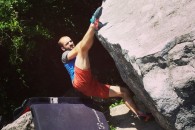







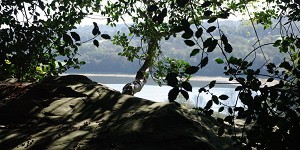

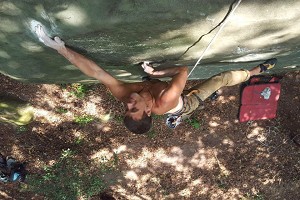
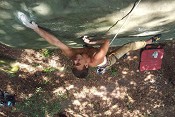
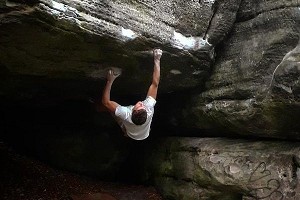

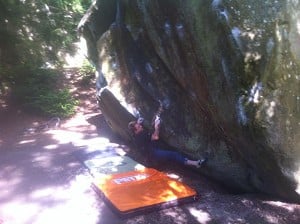
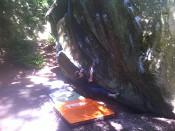
Comments
Great to hear so much is getting done, and that the guide has spurred on a bit of activity.
Good article, thanks! Has there been any updates on the ban at High Rocks? Last post I can find is back in August last year.
Yes, that's all I'm thinking about having read this. The huge potential tragedy of losing High Rocks as a stupendous climbing venue (largely, if the way it's been reported to me is correct, as a result of the blind stupidity of a very small number of selfish climbers). We can only hope that negotiations between the BMC and the owner are progressing positively, but fear that the owner is in absolutely no hurry after this extraordinary souring of relationships. All the years I climbed there, from the mid 70s to mid 80s, once we'd accepted that we had to pay the owner to go in, I remember the relationship between the regular climbers and the owner as being very amicable. I.e he trusted us, and we in turn spent money in his nice hotel.
A rather weird 'dislike' above. I would have thought that anyone who disagreed with my assessment would want to say why ... obviously taking into account the very delicate diplomatic situation. Or: if they disagree with me even raising the subject, surely they would say so?
Gordon, it looks as though they may have repented! Your assessment certainly got a 'Like' from me. The High Rocks situation seems such a pity. Hopefully it will be resolved. I only went there once, in the 1980s, and it wasn't in good condition - but what a crag!
Despite not having been to these places since the '80s and being too crap to get up most of the new problems anyway, I enjoy reading these reports. It's great that people are prepared to look at even highly developed areas with fresh eyes and make new finds. Innovation and enthusiasm - long may they continue!
Mick